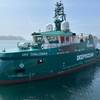Although it has a tradition of "keeping a low profile", China Ocean Shipping (Group) Company (COSCO) has provided something of a beacon for the industry in nurturing a seminal, safety-related development.
Its bold decision to fit a multi-function navigation support and tracking system, the product of Sino-British technical collaboration, aboard every unit of its near 500-strong fleet, undoubtedly advances the cause of digital chart-based electronic navigation. The resultant Global Navigation Intelligence System (GNIS) combines a raster chart display with meteorological, tidal, current and port data, plus route planning and fleet tracking, as well as search and rescue capabilities within a software and hardware regime which caters for the evolution of the various technologies. It therefore promises immediate safety and operational benefits, while serving the longer-term requirements of the shipowner.
Just as attention to quality in a shipbuilding environment can be favorable to productivity, a safety-driven approach in shipping can yield improved, long-run efficiency. COSCO thereby expects to achieve savings in its considerable bunkering bill, through greater navigational precision. For example, the calculation of a Great Circle route, and the computation and correction of track errors, is fully automatic under GNIS.
COSCO's pragmatism, in part a reflection of the seagoing background of most of its senior management, is complemented by the long-term vision expressed in its investment in GNIS. While first-hand bridge experience exists in depth among its decision-makers, with an attendant respect for the role of accumulated experience and knowledge in the science of navigation, the company is keenly aware of the impact and potential of "universal information" in application to shipboard systems.
GNIS is an embodiment of fundamental change in the tools of navigation and in the control of fleets. It allows all navigation functions to be effected in one place in a unified manner, giving instantaneous and accurate ship's position, course and track information, and should contribute to the watchkeeper's peace of mind and eliminate several potential sources of human error. Furthermore, the automated transmission of data back to the company's shoreside organization will strengthen COSCO's cargo tracing and tracking system, giving customers greater certainty regarding the status of goods in transit.
The outfit, which went aboard the 3,500-TEU containership Da He at the U.K. North Sea port of Felixstowe in September, marked the start of a five-year program to equip every existing vessel with GNIS. The equipment has also been incorporated into the technical specification for the entire COSCO newbuild program, currently running to more than 30 ships, including the recently booked further series of 5,250-TEU, wider-than-Panamax linehaul vessels from Kawasaki Heavy Industries. The immediate emphasis on retrofits promises early benefits from the system. The commonality of such equipment throughout the fleet, one of the world's largest, means that a COSCO deck officer will encounter the same type of navigation system on any ship. The shipping industry has not been noted for such standardization, which promotes rapid user familiarity and hence safety and efficiency, and COSCO can be commended in helping to steer matters in the right direction.
Key inputs to GNIS are the Admiralty Raster Chart Service (ARCS), the digital electronic charts provided in weekly-updated CD form by the UK Hydrographic Office(UKHO), and worldwide weather data sourced from the Chinese Meterological Administration's subsidiary Global Weather Routing Technology Company. The Suffolk-based company SCD, an Admiralty chart agent and ship delivery firm, is supplying the Navigator GNIS package, which has been developed in close co-operation with COSCO itself using a specialist British software firm, Electronic Navigation Systems (ENS).
While raster-based charts are at the heart of the system now being supplied, GNIS is fully compatible with vector system charts, as an important, future-oriented feature. Since worldwide coverage of ENC (vector) charts based on official data is still some way off, raster and so-called dual-fuel arrangements (using vector sets where available for localized areas) offer clear practical advantages for mariners and shipowners.
Sponsored Content
Experience Custom Yacht Signs and Designs Tailored to Perfection!

April 2025
 Read the Magazine
Read the Magazine

 Read the Magazine
Read the Magazine
This issue sponsored by:

From Oil to Wind: Cross-Skill Pilot Exemplifies Just-Transition in Action
Subscribe for
Maritime Reporter E-News
Maritime Reporter E-News is the maritime industry's largest circulation and most authoritative ENews Service, delivered to your Email five times per week








